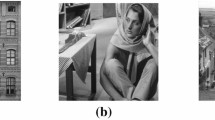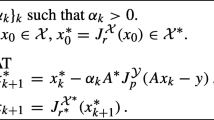Abstract
The recently introduced preconditioned Douglas–Rachford iteration (PDR) for convex–concave saddle-point problems is studied with respect to convergence rates and applied to variational imaging problems with total variation (TV) and total generalized variation (TGV) penalty. A rate of \({\mathcal {O}}(1/k)\) for restricted primal–dual gaps evaluated for ergodic sequences generated by the PDR iteration is established. Based on PDR, new fast iterative algorithms for TV-denoising, TV-deblurring, and TGV-denoising of second order with \(L^2\) and \(L^1\) discrepancy are proposed. While for denoising, symmetric (block) Red–Black Gauss–Seidel preconditioners are effective, fast Fourier transform-based preconditioners are employed for the deblurring problems. Finally, for the \(L^2\)-TGV-denoising problem, an effective modified primal–dual gap is developed which may serve as a stopping criterion. All algorithms are tested and compared in numerical experiments. In particular, for problems where strong convexity does not hold, it turns out that the proposed preconditioning techniques are beneficial and lead to competitive results.













Similar content being viewed by others
References
Boţ, R.I., Hendrich, C.: A Douglas-Rachford type primal–dual method for solving inclusions with mixtures of composite and parallel-sum type monotone operators. SIAM J. Optim. 23(4), 2541–2565 (2013a)
Boţ, R.I., Hendrich, C.: Solving monotone inclusions involving parallel sums of linear composed maximal monotone operators. arXiv:1306.3191 (2013b)
Bredies, K.: Recovering piecewise smooth multichannel images by minimization of convex functionals with total generalized variation penalty. In: Bruhn, A., Pock, T., Tai, X.C. (eds.) Efficient Algorithms for Global Optimization Methods in Computer Vision. Lecture Notes in Computer Science, pp. 44–77. Springer, Berlin (2014)
Bredies, K., Holler, M.: Artifact-free JPEG decompression with total generalized variation. In: Proceedings of VISAPP 2012—International Joint Conference on Computer Vision, Imaging and Computer Graphics Theory and Applications, pp. 12–21 (2012)
Bredies, K., Sun, H.P.: Preconditioned Douglas–Rachford splitting methods for convex–concave saddle-point problems. SIAM J. Numer. Anal. (2014, in press)
Bredies, K., Valkonen, T.: Inverse problems with second-order total generalized variation constraints. In: Proceedings of SampTA 2011—9th International Conference on Sampling Theory and Applications, Singapore (2011)
Bredies, K., Kunisch, K., Pock, T.: Total generalized variation. SIAM J. Imaging Sci. 3(3), 492–526 (2010)
Briceño-Arias, L., Combettes, P.L.: A monotone+skew splitting model for composite monotone inclusions in duality. SIAM J. Optim. 21(4), 1230–1250 (2011)
Chambolle, A., Pock, T.: A first-order primal–dual algorithm for convex problems with applications to imaging. J. Math. Imaging Vis. 40(1), 120–145 (2011)
Eckstein, J., Bertsekas, D.P.: On the Douglas-Rachford splitting method and the proximal point algorithm for maximal monotone operators. Math. Program. 55(1–3), 293–318 (1992)
Ekeland, I., Témam, R.: Convex Analysis and Variational Problems. No. 1 in Classics in Applied Mathematics, Society for Industrial and Applied Mathematics (1999)
Esser, E.: Applications of Lagrangian-based alternating direction methods and connections to split Bregman. Tech. rep., CAM report 09–2009, UCLA (2009)
Farrall, A.: Human brain MRI. http://www.anatomy.mvm.ed.ac.uk/museum/explore-anatomy.php (2011). Accessed 07 Feb 2014
Gabay, D.: Applications of the method of multipliers to variational inequalities. In: Fortin, M., Glowinski, R. (eds.) Augmented Lagrangian Methods: Applications to the Numerical Solution of Boundary-Value Problems, Studies in Mathematics and its Applications, vol. 15, pp. 299–331. Elsevier, Amsterdam (1983)
Gabay, D., Mercier, B.: A dual algorithm for the solution of nonlinear variational problems via finite element approximation. Comput. Math. Appl. 2(1), 17–40 (1976)
Goldstein, T., Osher, S.: The split Bregman method for \(L^1\)-regularized problems. SIAM J. Imaging Sci. 2(2), 323–343 (2009)
Ito, K., Kunisch, K.: Lagrange Multiplier Approach to Variational Problems and Applications. Society for Industrial and Applied Mathematics, Advances in Design and Control (2008)
Knoll, K., Bredies, K., Pock, T., Stollberger, R.: Second order total generalized variation (TGV) for MRI. Magn. Reson. Med. 65(2), 480–491 (2011)
Lions, P., Mercier, B.: Splitting algorithms for the sum of two nonlinear operators. SIAM J. Numer. Anal. 16(6), 964–979 (1979)
Lorenz, D.A., Pock, T.: An inertial forward-backward algorithm for monotone inclusions. arXiv:1403.3522 (2014)
Pock, T., Chambolle, A.: Diagonal preconditioning for first order primal–dual algorithms in convex optimization. In: IEEE International Conference on Computer Vision (ICCV), 2011, pp. 1762–1769 (2011)
Rockafellar, R.T.: Monotone operators and the proximal point algorithm. SIAM J. Control Optim. 14(5), 877–898 (1976)
Rudin, L.I., Osher, S., Fatemi, E.: Nonlinear total variation based noise removal algorithms. Physica D 60(1–4), 259–268 (1992)
Temam, R.: Mathematical Problems in Plasticity. Bordas (1985)
Thomas, J.W.: Numerical Partial Differential Equations: Conservation Laws and Elliptic Equations, Texts in Applied Mathematics, vol. 33. Springer, New York (1999)
Uzawa, H.: Iterative methods in concave programming. In: Arrow, K., Hurwicz, L., Uzawa, H. (eds.) Studies in Linear and Nonlinear Programming, pp. 154–165. Stanford University Press, Palo Alto (1958)
Vũ, B.C.: A splitting algorithm for dual monotone inclusions involving cocoercive operators. Adv. Comput. Math. 38(3), 667–681 (2013)
Valkonen, T., Bredies, K., Knoll, F.: Total generalized variation in diffusion tensor imaging. SIAM J. Imaging Sci. 6(1), 487–525 (2013)
Zhang, X.Q., Burger, M., Osher, S.: A unified primal–dual algorithm framework based on Bregman iteration. J. Sci. Comput. 46(1), 20–46 (2011)
Acknowledgments
The work of Kristian Bredies and Hongpeng Sun is supported by the Austrian Science Fund (FWF) under grant SFB32 (SFB “Mathematical Optimization and Applications in the Biomedical Sciences”). The Institute for Mathematics and Scientific Computing at the University of Graz is a member of NAWI Graz (http://www.nawigraz.at/).
Author information
Authors and Affiliations
Corresponding author
Rights and permissions
About this article
Cite this article
Bredies, K., Sun, H.P. Preconditioned Douglas–Rachford Algorithms for TV- and TGV-Regularized Variational Imaging Problems. J Math Imaging Vis 52, 317–344 (2015). https://doi.org/10.1007/s10851-015-0564-1
Received:
Accepted:
Published:
Issue Date:
DOI: https://doi.org/10.1007/s10851-015-0564-1




